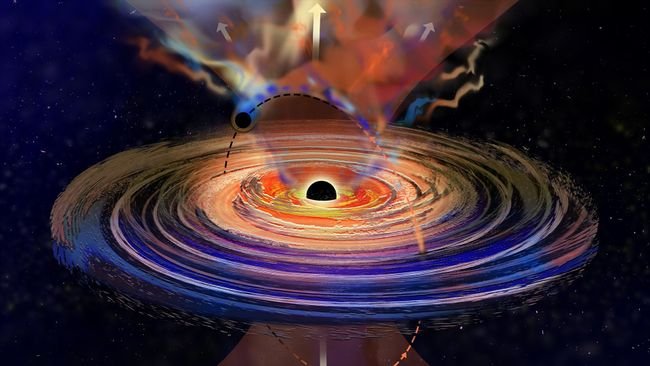Accrecinated disks of black holes are capable of housing larger objects than expected
Astronomers noticed the first case of «hiccups» black hole. Researchers have discovered that the massive black hole, which lies at the heart of a galaxy 800 million light-years away from Earth and weighs the equivalent of about 50 million Suns, regularly spews gas into space every 8.5 days. These «bouts of hiccups» occur due to the accretion disk, which is a ring of superheated matter rotating around the black hole itself.
These gas emissions are caused by a secondary black hole flying in an inclined orbit and picking up gas. Initially, the observations “came as a complete surprise,” said lead study author Dheeraj Pasham, a postdoctoral fellow at the Kavli Institute for Astrophysics and Space Research in Massachusetts. «We were confused for several months until theorists from the Czech Republic came and provided an explanation of a secondary black hole, which explained all the properties of this system».
Research has shown that accretion disks around black holes may be the «home» for various cosmic objects, including other black holes and stars.
In the words of Dheeraj Pasham: «We thought we already knew a lot about black holes, but this discovery shows that they hide much more. If our model for the existence of a secondary black hole is correct, then these outbursts of gas could reveal an entire population of extreme binary systems.
Researchers estimate that the black hole will eventually devour its companion in about 10,000 years.
The discovery of the main black hole was made in December 2020 thanks to the Automated Survey of Supernovae Telescopes (ASAS-SN). The study spotted a flash of light from the accretion disk, called ASASSN-20qc, making a small region 1,000 times brighter. The outbreak lasted four months and was probably caused by the «absorption» the nearest star is a supermassive black hole.
Follow-up observations with the X-ray telescope aboard the ISS allowed scientists to detect and catalog periodic dips in the X-ray data from the «feasting» object — just as a planet crossing the disk of its star briefly blocks its light. This was the «hiccup» black hole. Researchers have determined that the black hole «hiccupped» every time a spinning secondary black hole punctured an accretion disk.
Although the secondary black hole is smaller, it is not tiny. Scientists estimate it weighs between 100 and 10,000 times the size of the Sun, which classifies it as an intermediate mass black hole. The large difference between the masses of the two black holes, differing by a factor of 5000, makes the duo one of the most extreme binary systems discovered to date.
In the coming months, researchers plan to continue monitoring this system and study several other similar systems. If the binary black holes in the systems under study also have extreme differences in mass, then the European Space Agency's new telescope called the Space Laser Interferometer Antenna will help. (LISA) should be able to detect them.

